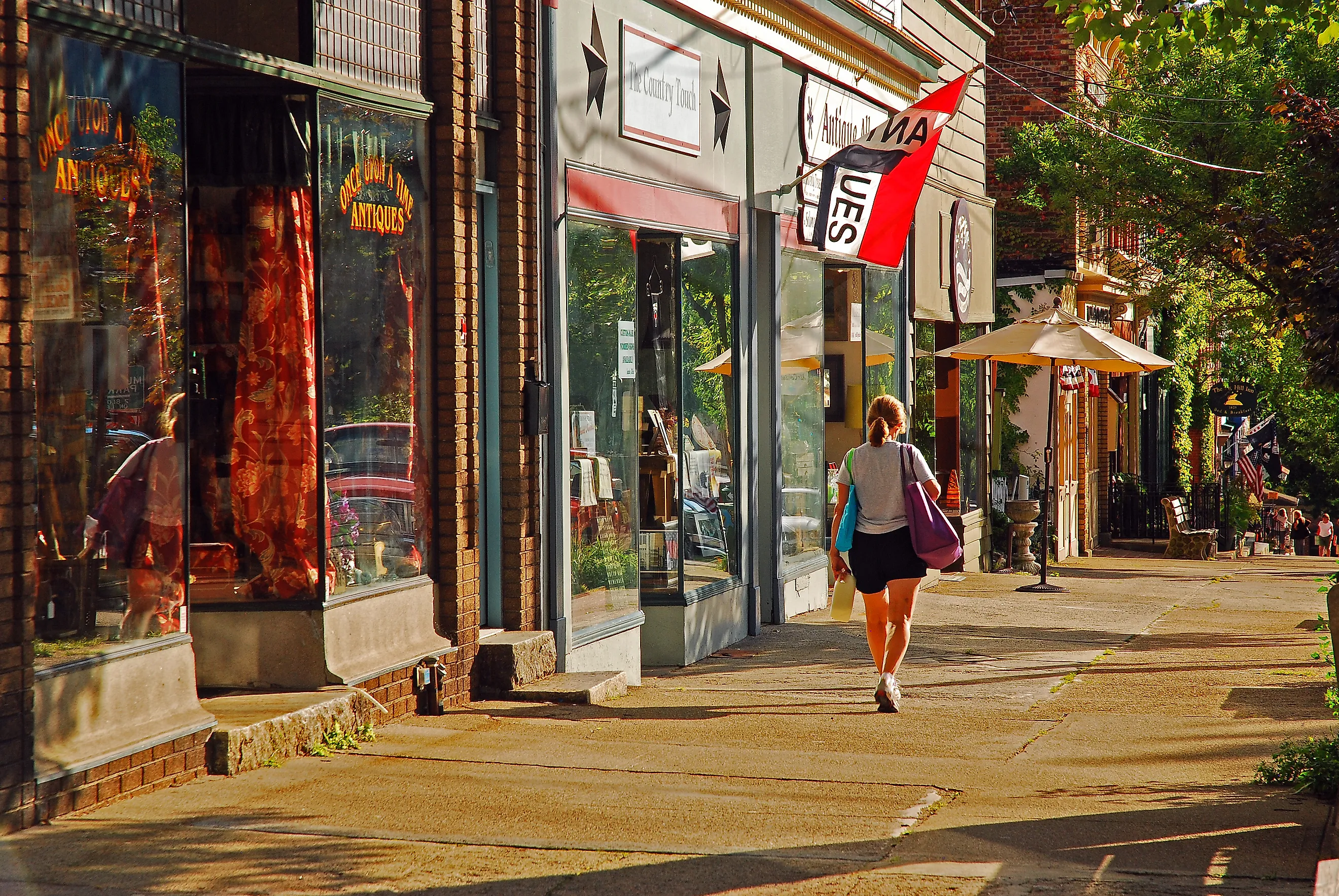
10 Most Charming Town Squares In New York
New York has a square problem: the most famous one isn’t in this story. The state’s best squares live far from neon, places where a carousel spins beside a marina, a bandstand hosts Tuesday brass, and a pedestrian mall ends at a gorge. These centers weren’t designed as photo ops; they’re working rooms for parades, protests, and lunch breaks, stitched together with brick arcades, clapboard storefronts, and courthouse lawns.
In our list of ten towns, expect lakefront greens, rail-side plazas, triangular village commons, and one square that’s more axis than plaza. No itinerary gymnastics, just centers that still hold, and tell you exactly where to stand.
Ithaca
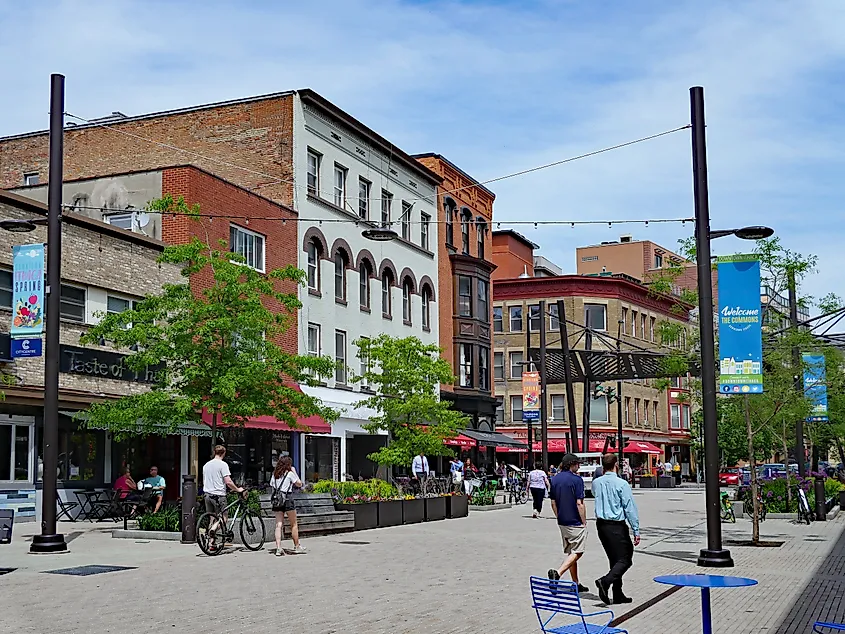
Ithaca’s Commons is a pedestrian mall set within a college town that happens to border multiple gorges, waterfalls, and a finger lake. But unlike other small towns with pretty backdrops, Ithaca has layers: it’s home to the Moe’s Southwest Grill, a feminist bookstore with no prices (Autumn Leaves), and a literal science museum in a former sewage plant. The Commons itself is walkable and oddly vertical, surrounded by architecture ranging from Second Empire to 1970s brutalism. Cornell’s presence gives the square intellectual grit, while its independent spirit is protected by a permanent ban on chain stores.
Several anchors define the town center. Buffalo Street Books operates as a co-op inside the historic DeWitt Mall, right next to GreenStar Food Co-op, which serves community-sourced lunches. A few blocks west, Moosewood Restaurant still runs daily menus inside the former fire station it helped make famous in the 1970s. The Herbert F. Johnson Museum of Art, designed by I.M. Pei, sits just uphill, offering rotating global collections and a panoramic view of Cayuga Lake. For a close encounter with the water, Stewart Park offers picnic spots and a flat lakefront trail just minutes from the square.
Saratoga Springs
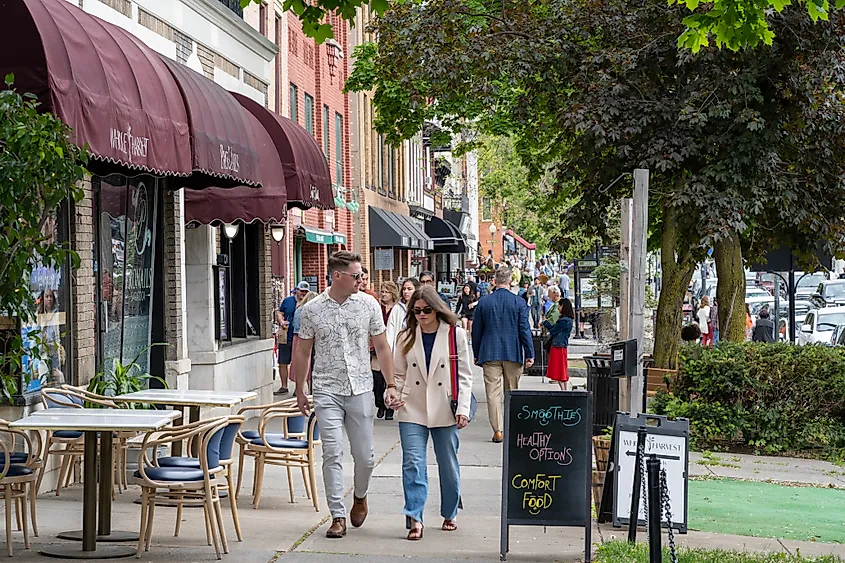
Saratoga Springs built its identity around water; its 21 mineral springs once drew visitors for their supposed healing properties, and the town still preserves public fountains, tasting pavilions, and bathhouses across its compact core. Congress Park is its unofficial square, a landscaped remnant of the 19th-century resort boom designed in part by Frederick Law Olmsted. The park includes a fully functioning 1910 wooden carousel and the Canfield Casino, a Gilded Age gambling hall turned museum. Downtown architecture ranges from Victorian mansions to 20th-century storefronts with cast-iron detailing, giving Broadway a visibly layered commercial history.
Within a four-block radius of Congress Park, several institutions remain active. The Saratoga Springs History Museum occupies the upper floors of the Canfield Casino, preserving local ephemera and period rooms. Just up Broadway, Uncommon Grounds Coffee & Bagels serves house-roasted beans in a two-story space that fills by 8 a.m. most weekends. Across the street, Northshire Bookstore spans multiple rooms and hosts author talks and events year-round. The Adirondack Trust Company building anchors the intersection of Broadway and Church Street with its distinctive 1916 Beaux-Arts façade, signaling the town’s transition from health resort to permanent, well-funded cultural hub.
Cooperstown
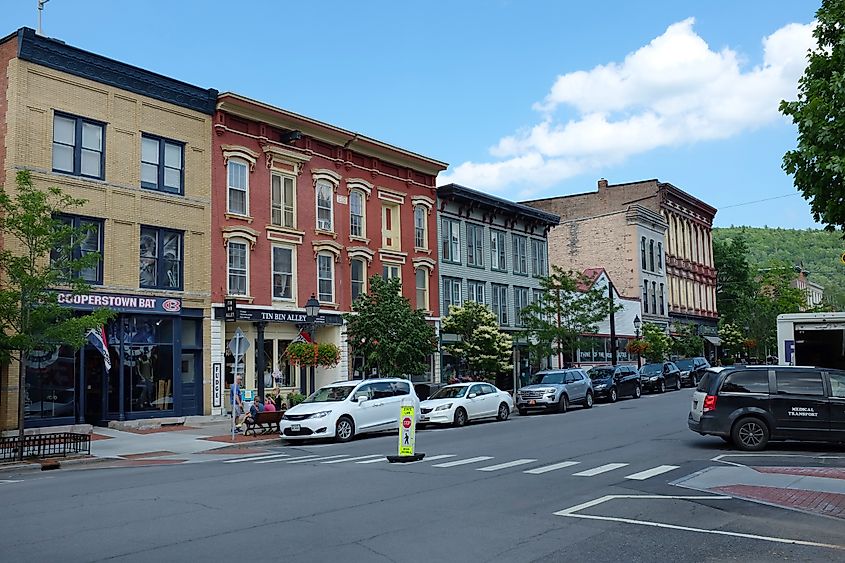
Baseball mythology made Cooperstown famous, but the town’s square and surrounding blocks offer more than just Cooperstown Dreams Park merchandise. Its Main Street terminates at Lakefront Park, where the docks of Otsego Lake host the Glimmerglass Queen boat tours. The village green, Pioneer Park, functions as the civic heart, marked by a small pavilion and flagpole where weekend musicians and farmers’ markets gather. The town’s founding family, the Coopers, specifically novelist James Fenimore Cooper, still shapes local identity, down to the lake’s poetic nickname “Glimmerglass,” taken from The Deerslayer.
Two blocks from the square, the National Baseball Hall of Fame and Museum houses thousands of artifacts and hosts induction ceremonies that briefly swell the population into the tens of thousands. Further down Main, Schneider’s Bakery has sold half-moon cookies, cinnamon twists, and salt sticks since 1887. Across the street, Stagecoach Coffee roasts beans in-house and operates from a brick-and-timber storefront with sidewalk tables. At the far end of the street, the Fenimore Art Museum offers rotating American folk art exhibits and a curated view of Otsego Lake from its back lawn.
Skaneateles
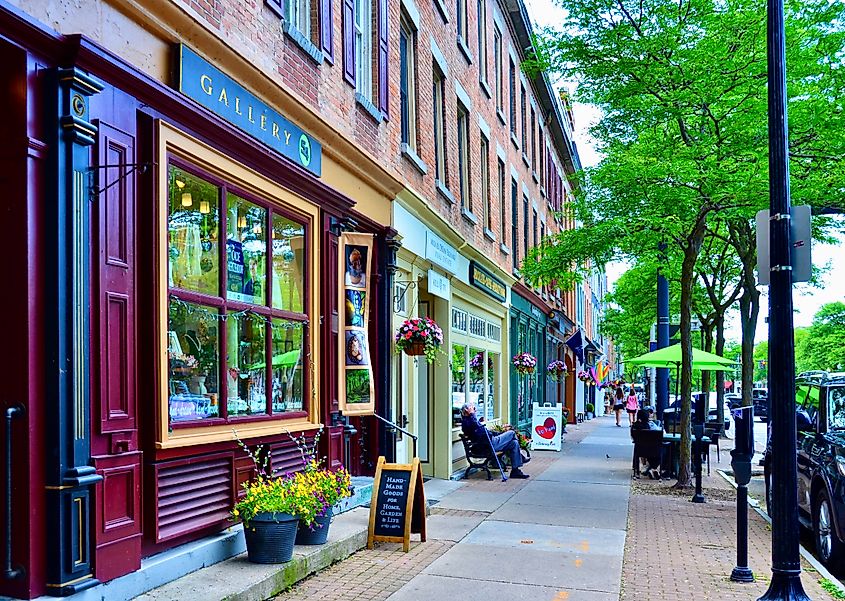
Skaneateles operates on a tight scale: a single commercial block, a lakeside pier, and a church steeple define its center. However, the clarity of that triangle gives it a structure that only a few lake towns maintain. The water is municipal-grade clean, pulled directly from Skaneateles Lake without filtration, and the lake itself has no industrial shoreline, just boathouses, pastures, and long private drives. The square is less of a plaza than an intersection, where Genesee, Jordan, and East Lake Roads meet at Clift Park, a grass parcel with benches, a bandstand, and a public swimming area bordered by iron fencing.
Along Genesee Street, Doug’s Fish Fry draws lines year-round for fried scallops, haddock sandwiches, and homemade pie. The Sherwood Inn has been operating since 1807 and maintains views of the water from nearly every seat. For a short cruise, the Judge Ben Wiles departs daily in summer from the town dock just past Shotwell Park. The boat belongs to Mid-Lakes Navigation, a family-run operation based here since the 1960s. Together, the dock, the park, and a single curved street hold the commercial and civic life of the town without needing expansion.
Rhinebeck
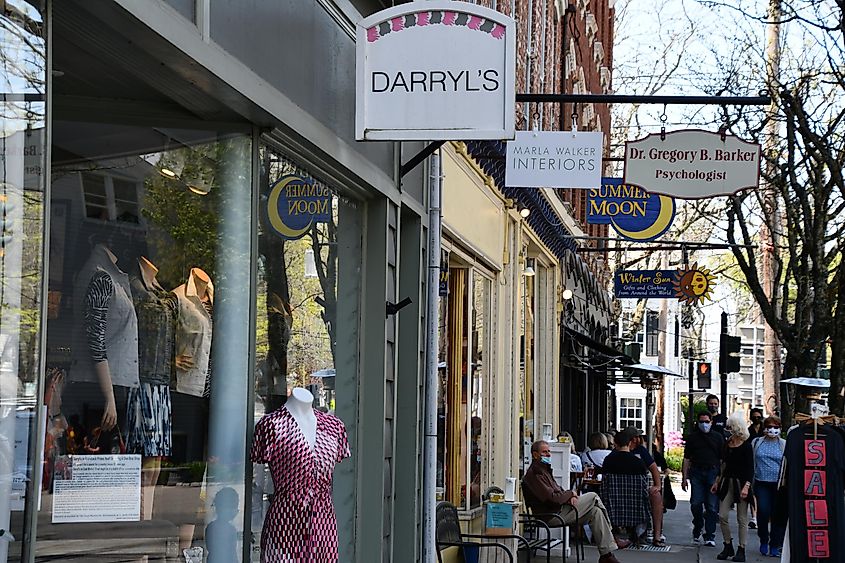
Rhinebeck’s center occupies a wedge where Market and Montgomery Streets meet, with the Beekman Arms & Delamater Inn as its fixed point. Operating since 1766, it claims to be America’s oldest continuously running inn. The sidewalks still follow the layout of early Dutch settlement patterns, and street names haven’t shifted in over 200 years. Seasonal traffic filters in from Bard College, nearby estates, and weekend Amtrak visitors, but the town keeps a deliberate pace. Storefronts are preserved in place: no modern facades, no faux-historic brickwork.
At the intersection, Upstate Films plays limited-run documentaries and hosts regional festivals from a single-screen 1920s theater. Just north, Samuel’s Sweet Shop stocks imported licorice and house-made marshmallows inside a Victorian storefront co-owned by two actors with local ties. On the opposite corner, Bread Alone serves seeded rye and espresso in what was once the town firehouse. A block south, Oblong Books runs weekly readings and keeps a curated selection of small-press titles and zines. The square remains unpaved in feeling, despite modern infrastructure, no stoplights, only signs and habit controlling the intersection. Its charm comes from density and continuity rather than nostalgia or replication.
Cold Spring

Cold Spring’s layout hasn’t changed since the 19th century, and its core remains shaped by the iron foundry that once supplied cannons to West Point. The town’s Main Street runs straight to the Hudson, ending at Dockside Park, where train tracks separate the commercial strip from a flat spit of riverfront grass. The walkable stretch holds fewer than three dozen businesses, but Cold Spring’s square, centered loosely around the intersection of Main and Depot, functions as a pause point for hikers, writers, and Metro-North day-trippers. The surrounding cliffs of Breakneck Ridge and Bull Hill enclose the town in a steep bowl.
Near the river, Cold Spring Depot serves burgers and trout cakes in a repurposed 1893 station house, with outdoor seating that flanks the active rail line. Midway up the street, Split Rock Books stocks trail guides, local authors, and translated fiction in a two-room space lined with pine shelves. Just uphill, the entrance to the West Point Foundry Preserve opens to a self-guided trail past blast furnaces and casting pits, all overgrown with second-growth forest.
Woodstock
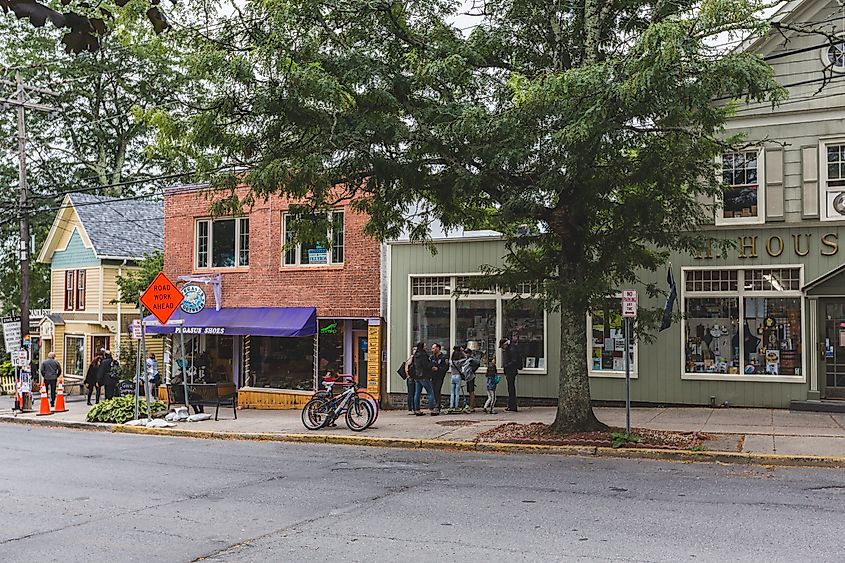
Woodstock has no formal square, but its Village Green, a triangular plot bordered by Tinker, Mill Hill, and Rock City Roads, acts as the gravitational center. The town never hosted the 1969 festival that bears its name, but it has housed artists since the early 20th century, beginning with the Byrdcliffe Arts Colony. The Green remains a performance space and informal forum, with buskers, drum circles, and small protests appearing without schedule. Surrounding it are clapboard storefronts, unlined parking, and galleries housed in converted homes. The streets curve slightly, breaking the grid and holding views of the Catskill foothills.
Across from the Green, Oriole 9 serves shakshuka and smoked trout hash in a modern diner layout, often with a wait. A block up Mill Hill Road, Woodstock Artists Association & Museum exhibits regional painting and sculpture in rotating shows, with a permanent collection of Hudson Valley modernists. Down Tinker Street, Tinker Street Cinema screens international films in a former synagogue, retaining original arched windows and woodwork. Just past the gallery row, Mower’s Saturday Market sets up behind Bread Alone Bakery with antique tools, LPs, and seasonal produce. The town’s center remains informal by design, with part park, part plaza, and part open-air stage, anchored by the absence of commercial uniformity.
Lake Placid
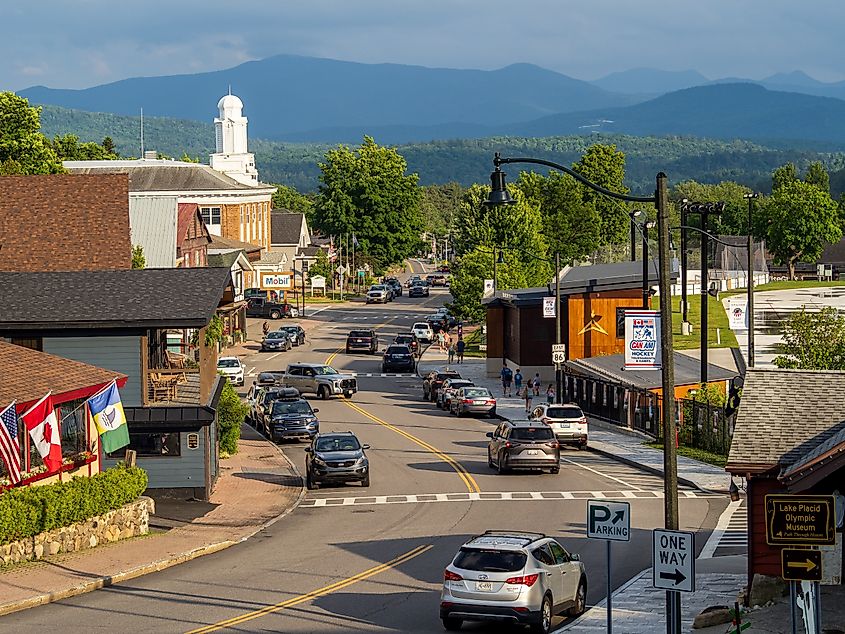
Lake Placid’s Main Street bends along the eastern edge of Mirror Lake, framing the village in a narrow, elevated strip that once served two Olympic Games. The town's infrastructure reflects that legacy; its square is not geometric but circulatory, anchored by the Olympic Center, where the 1980 “Miracle on Ice” took place. Flags of competing nations still line the plaza, and the Lake Placid Olympic Museum, located within the same complex, displays equipment, uniforms, and torches from both 1932 and 1980. The sidewalk just outside leads directly to the lakefront, where a toboggan chute extends onto the frozen surface each winter.
Two blocks north, The Bookstore Plus stocks regional titles and signed editions in a two-level shop facing the water. Across the street, Origin Coffee Co. serves pour-over flights and pastries made in-house, with an upstairs space overlooking the lake and hills. Further up Main Street, Emma’s Lake Placid Creamery draws year-round crowds for its maple soft serve and “whiteface” sundaes. The town beach, public and open seasonally, lies directly behind the Main Street corridor. Lake Placid’s version of a square is split between Olympic memory and lake access, more axis than plaza, but the effect is complete, with Main Street as its uninterrupted spine.
Greenport
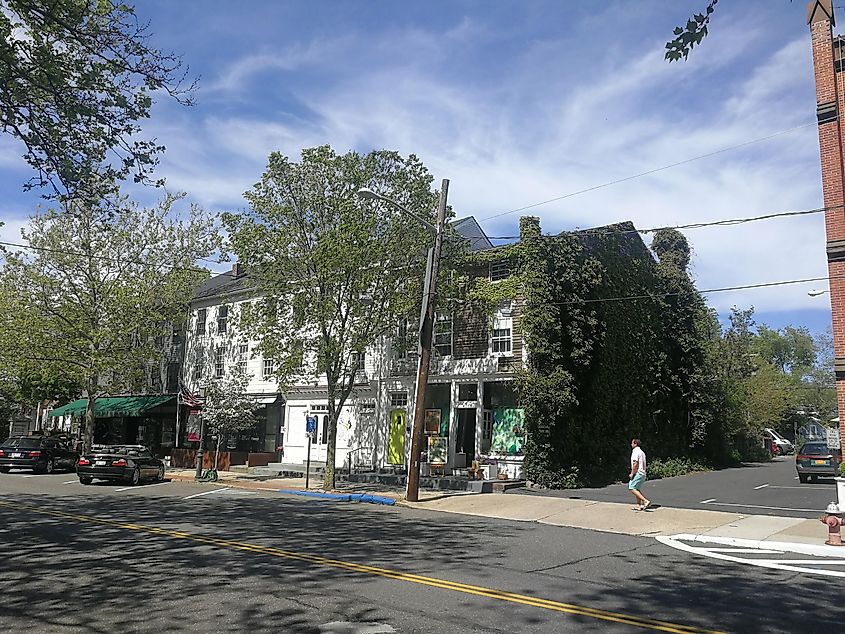
Greenport was once a whaling port, then a bootlegging stop, then a ferry town, and parts of all three remain in its core layout. The square is more of a waterfront axis where Front and Main Streets meet Mitchell Park, a flat parcel housing a 1920s carousel, a seasonal skating rink, and dock access to Shelter Island ferries. The East End Seaport Museum sits at the park’s eastern edge, inside the former Long Island Railroad freight building, and maintains a lens room salvaged from the nearby Bug Light lighthouse. The town’s marina operates just behind it, bordered by low brick warehouses converted into tasting rooms and cafés.
Main Street runs perpendicular to the water. Aldo’s Coffee Company, one block off the park, roasts its own beans and sells biscotti by weight. On 211 Carpenter St., Little Creek Oyster Farm & Market serves oysters pulled from Peconic Bay with housemade mignonette, and rents shuck-your-own kits. Just inland, Lucharitos Taqueria & Tequila Bar anchors the corner of Main and Bay, filling by 6 p.m. on summer weekends. The town’s layout gives each block a clear function: port, park, market, rail.
Hammondsport
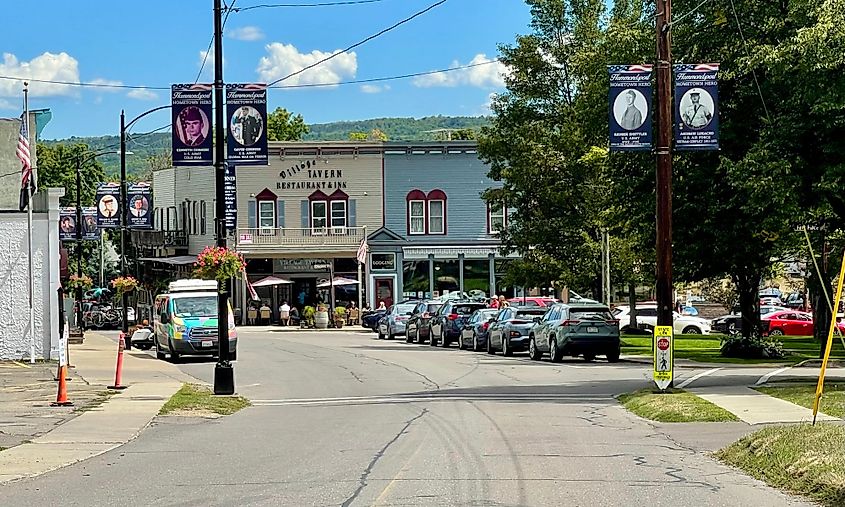
Hammondsport occupies the south end of Keuka Lake and holds a defined square: Pulteney Square, a fenced village green surrounded by 19th-century facades, shaded walkways, and flagstone sidewalks. The town is the birthplace of aviation pioneer Glenn Curtiss, whose motorcycle shop evolved into an aircraft factory and whose legacy defines the cultural geography of the area. Street signs still use his surname as a directional point. Unlike other Finger Lakes towns, Hammondsport never expanded into sprawl; the commercial district ends within four blocks of the shoreline.
One block from the square, the Glenn H. Curtiss Museum houses full-scale aircraft, motorcycles, and early aviation patents in a converted hangar. Along Shethar Street, Crooked Lake Ice Cream Company serves cones and sundaes from a bay-window storefront that opens directly to the sidewalk. At the lake’s edge, Depot Park sits on the footprint of the town’s former rail terminal, with boat slips, a seasonal beach, and benches facing the Y-shaped inlet. Hammondsport’s square holds as much aviation history as lakeside commerce, tied together by a fixed green that has remained the town’s center of gravity for over 150 years.
Squares like these aren’t backdrops; they’re operating manuals for their towns. Follow benches to bakeries, bandstands to bulletin boards, ferry slips to carousels. Springs still pour in Saratoga; an I.M. Pei museum crowns Ithaca; Cold Spring’s foundry trail starts on Main; Lake Placid keeps ice in its center; Greenport knots rail to harbor; Hammondsport ties air to lake. Choose any. Sit, listen, and you’ll understand the map without unfolding it.











